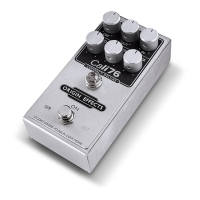6
Origin E ects Cali76 FET Compressor
NOTE: The DRY control and OUT control are separate level controls, so you will need to decrease the OUT control as
you increase the DRY control to maintain the same overall volume.
RATIO: This control adjusts the ratio of the compression. In other words, how much gain reduction is applied
to signals that exceed the fi xed threshold of the compressor. This control ranges from a ratio of 4:1 all the
way to 20:1. Generally, higher ratios are used when less of the signal is exceeding the threshold (lower settings
on the IN control). Setting the RATIO high and the IN control low will mean just the peaks of the signal are
clamped down quite severely. High IN settings with lower ratios result in a gentle fattening of the whole signal.
ATTACK: This control sets how quickly the compressor starts acting after the signal exceeds the threshold.
With a guitar signal, the fi rst part of the note is the loudest part, so the signal will exceed the threshold almost
instantaneously. A longer attack time allows the initial pick attack through before the rest of the signal is com-
pressed, creating an exaggerated percussive e ect. Fast attack times will reduce pick attack and create very
smooth, even dynamics. The ATTACK control’s fastest setting is fully clockwise. Attack times range from 0.2
ms to 4.8 ms.
RELEASE: This control sets how quickly the compressor stops acting after the signal begins to drop in level.
Longer release times will result in increased sustain, as the tail of the note continues to be compressed. Shorter
release times will allow the compressor to recover between notes, giving a more lively and natural dynamic
response. The RELEASE control’s fastest setting is fully clockwise. Release times range from 69.5 ms to 398 ms.
Metering: The Cali76 FET Compressor is equipped with a 10-LED bar graph gain reduction meter, giving an
accurate visual indication of what the compression circuit is doing. Once the signal exceeds the fi xed threshold,
the LEDs will begin to illuminate. Marked according to dB of gain reduction, the gain reduction meter shows not
only how severely the signal peaks are being compressed, but also how fast the compressor is acting.
Controls (continued):

